Metal-Free Catalytic Preparation of Graphene Films on a Silicon Surface Using CO as a Carbon Source in Chemical Vapor Deposition
Abstract
:1. Introduction
2. Experimental Methods
2.1. Preparation of Graphene Films
2.2. Characterization of Graphene Films
3. Experimental Results and Discussion
3.1. Surface Micromorphology
3.2. Surface Composition
3.3. Analysis of the Formation Mechanism
3.4. Electrical Properties of Graphene Films
4. Conclusions
Author Contributions
Funding
Institutional Review Board Statement
Informed Consent Statement
Data Availability Statement
Acknowledgments
Conflicts of Interest
References
- Seo, J.; Lee, J.; Jang, A.; Choi, Y.; Kim, U.; Shin, H.; Park, H. Study of Cooling Rate on the Growth of Graphene via Chemical Vapor Deposition. Chem. Mater. 2017, 29, 4202–4208. [Google Scholar] [CrossRef]
- Wang, J.; Jin, X.; Li, C.; Wang, W.; Wu, H.; Guo, S. Graphene and graphene derivatives toughening polymers: Toward high toughness and strength. Chem. Eng. J. 2019, 370, 831–854. [Google Scholar] [CrossRef]
- Lin, H.C.; Jian, Q.F.; Bai, X.Y.; Li, D.Q.; Huang, Z.; Huang, W.T.; Feng, S.S.; Cheng, Z.G. Recent advances in thermal conductivity and thermal applications of graphene and its derivatives nanofluids. Appl. Therm. Eng. 2023, 218, 119176. [Google Scholar] [CrossRef]
- Ghosal, S.; Mondal, N.S.; Chowdhury, S.; Jana, D. Two novel phases of germa-graphene: Prediction, electronic and transport applications. Appl. Surf. Sci. 2023, 614, 156107. [Google Scholar] [CrossRef]
- Zhang, Y.; Xia, X.; Liu, B.; Deng, S.; Xie, D.; Liu, Q.; Wang, Y.; Wu, J.; Wang, X.; Tu, J. Multiscale Graphene-Based Materials for Applications in Sodium Ion Batteries. Adv. Energy Mater. 2019, 9, 1803342. [Google Scholar] [CrossRef]
- Pang, J.; Mendes, R.G.; Wrobel, P.S.; Wlodarski, M.D.; Ta, H.Q.; Zhao, L.; Giebeler, L.; Trzebicka, B.; Gemming, T.; Fu, L.; et al. Terminating Confinement Approach for Large-Area Uniform Monolayer Graphene Directly over Si/SiO\r, x\r, by Chemical Vapor Deposition. ACS Nano 2017, 11, 46–1956. [Google Scholar] [CrossRef] [PubMed]
- Wuttke, M.; Liu, Z.; Lu, H.; Narita, A.; Müllen, K. Direct Metal-Free Chemical Vapor Deposition of Graphene Films on Insulating Substrates for Micro-Supercapacitors with High Volumetric Capacitance. Batter. Supercaps 2019, 2, 929–933. [Google Scholar] [CrossRef] [Green Version]
- Tai, L.; Zhu, D.; Liu, X.; Yang, T.; Wang, L.; Wang, R.; Jiang, S.; Chen, Z.H.; Xu, Z.; Li, X. Direct Growth of Graphene on Silicon by Metal-Free Chemical Vapor Deposition. Nano-Micro. Lett. 2018, 10, 20. [Google Scholar] [CrossRef] [Green Version]
- Kruskopf, M.; Pierz, K.; Wundrack, S.; Stosch, R.; Dziomba, T.; Kalmbach, C.C.; Müller, A.; Baringhaus, J.; Tegenkamp, C.; Ahlers, F.J.; et al. Epitaxial Graphene on SiC: Modification of Structural and Electron Transport Properties by Substrate Pretreatment. J. Phys. Condens. Matter. 2015, 27, 185303. [Google Scholar] [CrossRef]
- Phong, N.; Behura, S.K.; Seacrist, M.R.; Berry, V. Intergrain Diffusion of Carbon Radical for Wafer-Scale, Direct Growth of Graphene on Si-Based Dielectrics. ACS Appl. Mater. Interfaces 2018, 10, 26517–26525. [Google Scholar] [CrossRef]
- Li, X.; Colombo, L.; Ruoff, R.S. Synthesis of Graphene Films on Copper Foils by Chemical Vapor Deposition. Adv. Mater. 2016, 28, 6264. [Google Scholar] [CrossRef] [PubMed]
- Lee, E.; Lee, S.G.; Lee, H.C.; Jo, M.; Yoo, M.S.; Cho, K. Direct Growth of Highly Stable Patterned Graphene on Dielectric Insulators using a Surface-Adhered Solid Carbon Source. Adv. Mater. 2018, 30, 1706569. [Google Scholar] [CrossRef] [PubMed]
- Ismach, A.; Druzgalski, C.; Penwell, S.; Zheng, M.; Javey, A.; Bokor, J.; Zhang, Y. Direct Chemical Vapor Deposition of Graphene on Dielectric Surfaces. Nano Lett. 2010, 10, 1542–1548. [Google Scholar] [CrossRef] [PubMed]
- Kim, H.H.; Chung, Y.; Lee, E.; Lee, S.K.; Cho, K. Water-free transfer method for CVD-grown graphene and its application to flexible air-stable graphene transistors. Adv. Mater. 2014, 26, 3213–3217. [Google Scholar] [CrossRef] [PubMed]
- Lee, W.H.; Park, J.; Sim, S.H.; Lim, S.; Cho, K. Surface-Directed Molecular Assembly of Pentacene on Monolayer Graphene for High-Performance Organic Transistors. J. Am. Chem. Soc. 2011, 133, 4447–4454. [Google Scholar] [CrossRef]
- Seekaew, Y.; Nantikan, T.; Adisorn, T.; Tanom, L.; Anurat, W.; Chatchawal, W. Conversion of Carbon Dioxide into Chemical Vapor Deposited Graphene with Controllable Number of Layers via Hydrogen Plasma Pre-Treatment. Membranes 2022, 12, 796. [Google Scholar] [CrossRef]
- Mu?Oz, R.; Munuera, C.; Martínez, J.I.; Azpeitia, J.; Gómez, A.; García, H. Low temperature metal free growth of graphene on insulating substrates by plasma assisted chemical vapor deposition. 2D Mater. 2016, 4, 015009. [Google Scholar] [CrossRef] [Green Version]
- Strudwick, A.J.; Weber, N.E.; Schwab, M.G.; Kettner, M.; Weitz, R.T.; Wünsch, J.R.; Müllen, K.; Sachdev, H. Chemical Vapor Deposition of High Quality Graphene Films from Carbon Dioxide Atmospheres. ACS Nano 2015, 9, 31–42. [Google Scholar] [CrossRef] [Green Version]
- Weber, N.E.; Binder, A.; Kettner, M.; Hirth, S.; Weitz, R.T.; Tomovi, Z. Metal-free synthesis of nanocrystalline graphene on insulating substrates by carbon dioxide-assisted chemical vapor deposition. Carbon 2017, 112, 201–207. [Google Scholar] [CrossRef]
- Zada, A.; Khan, M.; Hussain, Z.; Shah, M.I.A.; Ateeq, M.; Ullah, M.; Dang, A. Extended visible light driven photocatalytic hydrogen generation by electron induction from g-C3N4 nanosheets to ZnO through the proper heterojunction. Z. Für Phys. Chem. 2022, 236, 53–66. [Google Scholar] [CrossRef]
- Lv, C.; Cheng, H.; He, W.; Shah, M.I.A.; Xu, C.; Meng, X.; Jiao, L.; Wei, S.; Li, J.; Liu, L.; et al. Pd 3 cluster catalysis: Compelling evidence from in operando spectroscopic, kinetic, and density functional theory studies. Nano Res. 2016, 9, 2544–2550. [Google Scholar] [CrossRef]
- Liu, Q.F.; Gong, Y.P.; Wang, T.; Chan, W.L.; Wu, J. Metal-catalyst-free and controllable growth of high-quality monolayer and AB-stacked bilayer graphene on silicon dioxide. Carbon 2016, 96, 203–211. [Google Scholar] [CrossRef] [Green Version]
- Stankus, V.; Vasiliauskas, A.; Guobien, A.; Andruleviius, M.; Mekinis, A. Direct synthesis of graphene on silicon by reactive magnetron sputtering deposition. Surf. Coat. Technol. 2022, 437, 128361. [Google Scholar] [CrossRef]
- Yang, J.; Jiang, Q.; Chen, Z.; Hu, P.A.; Li, J.J.; Guo, C.Z.; Yu, G. Transfer-free synthesis of multilayer graphene on silicon nitride using reusable gallium catalyst. Diam. Relat. Mater. 2019, 91, 112–118. [Google Scholar] [CrossRef]
- Chen, J.; Wen, Y.; Guo, Y.; Wu, B.; Huang, L.P.; Xue, Y.Z.; Geng, D.C.; Wang, D.; Yu, G.; Liu, Y.Q. Oxygen-Aided Synthesis of Polycrystalline Graphene on Silicon Dioxide Substrates. J. Am. Chem. Soc. 2011, 133, 17548–17551. [Google Scholar] [CrossRef]
- Bremmer, G.M.; Zacharaki, E.; Sjåstad, A.O.; Navarro, V.; Frenken, J.W.; Kooyman, P.J. In situ TEM observation of the Boudouard reaction: Multi-layered graphene formation from CO on cobalt nanoparticles at atmospheric pressure. Faraday Discuss. 2017, 197, 337–351. [Google Scholar] [CrossRef] [Green Version]
- Chakrabarti, A.; Lu, J.; Skrabutenas, J.C.; Xu, T.; Xiao, Z.; Maguire, J.A.; Hosmane, N.S. Conversion of carbon dioxide to few-layer graphene. J. Mater. Chem. 2011, 21, 9491–9493. [Google Scholar] [CrossRef]
- Zhai, Z.; Shen, H.; Chen, J.; Li, X.; Jiang, Y. Evolution of structural and electrical properties of carbon films from amorphous carbon to nanocrystalline graphene on quartz glass by HFCVD. ACS Appl. Mater. Interfaces 2018, 10, 17427–17436. [Google Scholar] [CrossRef]
- Losurdo, M.; Giangregorio, M.M.; Capezzuto, P.; Bruno, G. Graphene CVD growth on copper and nickel: Role of hydrogen in kinetics and structure. Phys. Chem. Chem. Phys. 2011, 13, 20836–20843. [Google Scholar] [CrossRef]
- Elias, D.C.; Nair, R.R.; Mohiuddin, T.M.G.; Morozov, S.V.; Blake, P.; Halsall, M.P.; Ferrari, A.C.; Boukhvalov, D.W.; Katsnelson, M.I.; Geim, A.K. Control of graphene’s properties by reversible hydrogenation: Evidence for graphane. Science 2009, 323, 610–613. [Google Scholar] [CrossRef] [Green Version]
- Kim, H.; Lee, Y.; Bae, S. Roll-to-roll production of 30-inch graphene films for transparent electrodes. Nat. Nanotechnol. 2010, 5, 574–578. [Google Scholar] [CrossRef] [Green Version]
- Li, X.; Zhu, Y.; Cai, W.; Han, B.; Chen, D.; Piner, R.D.; Colombo, L.; Ruoff, R.S. Transfer of Large-Area Graphene Films for High-Performance Transparent Conductive Electrodes. Nano Lett. 2009, 9, 4359–4363. [Google Scholar] [CrossRef] [PubMed]
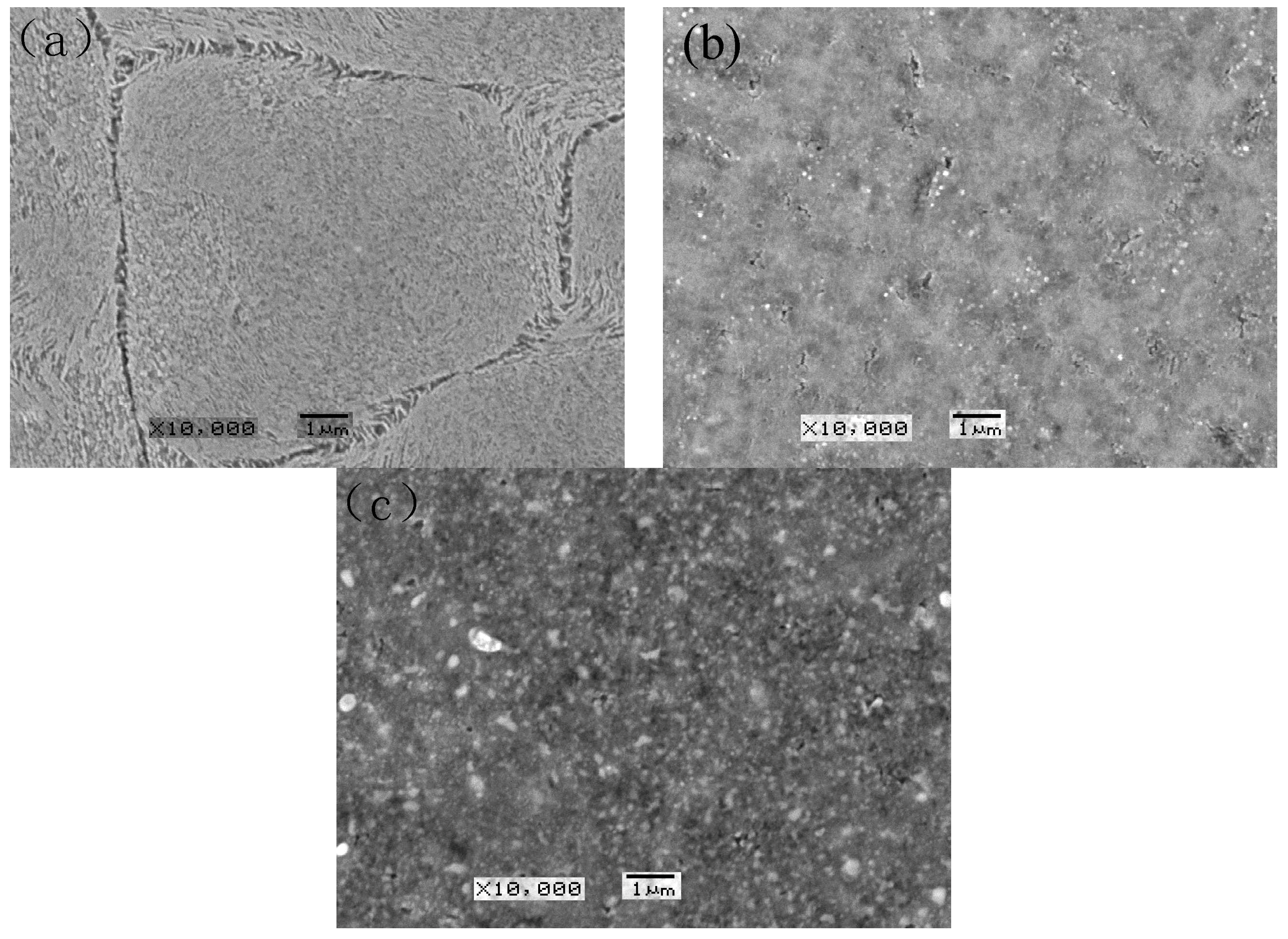
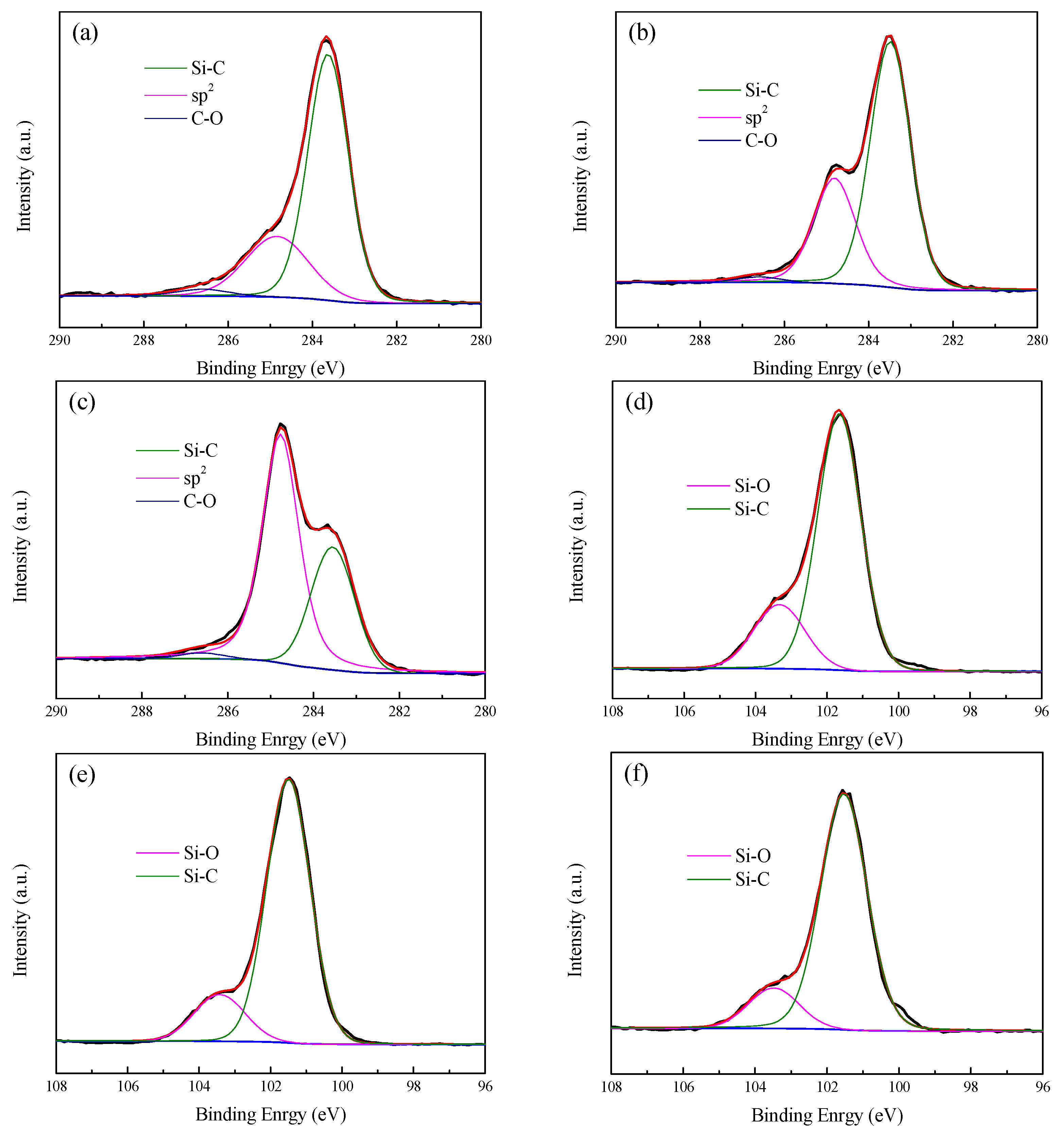
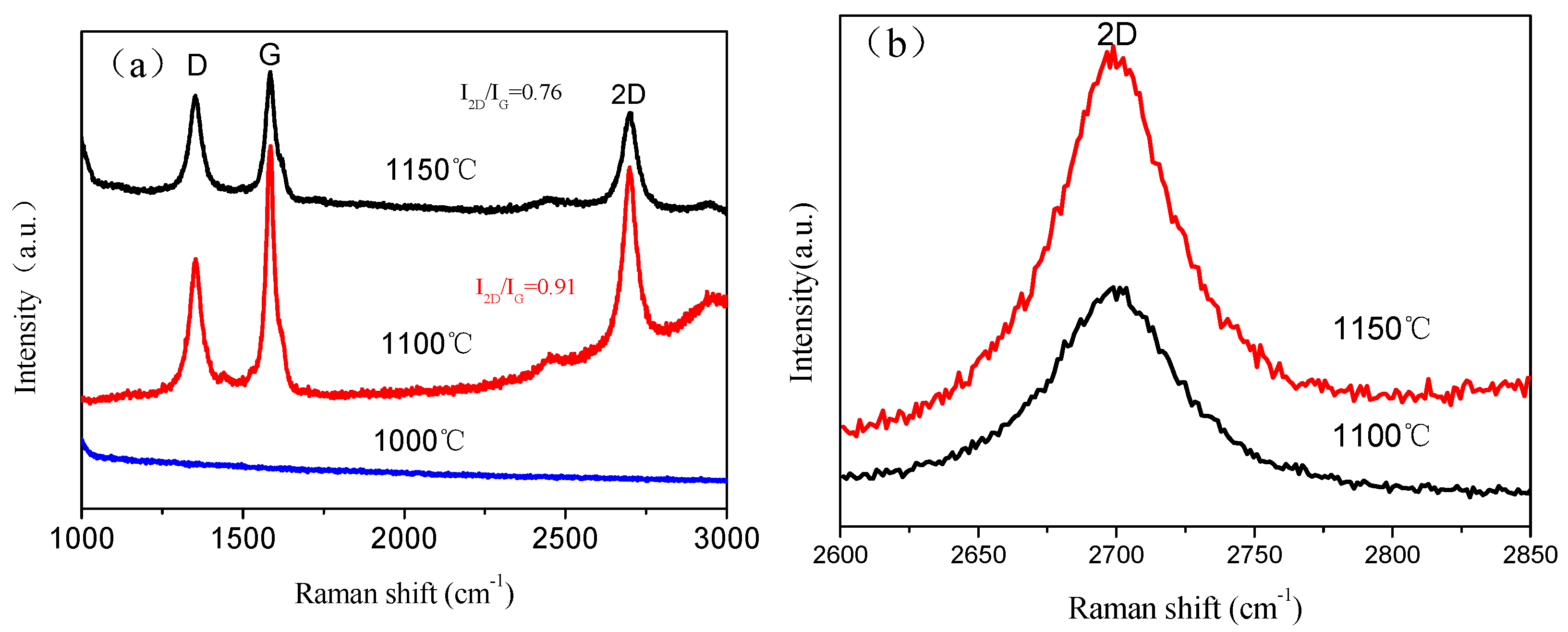
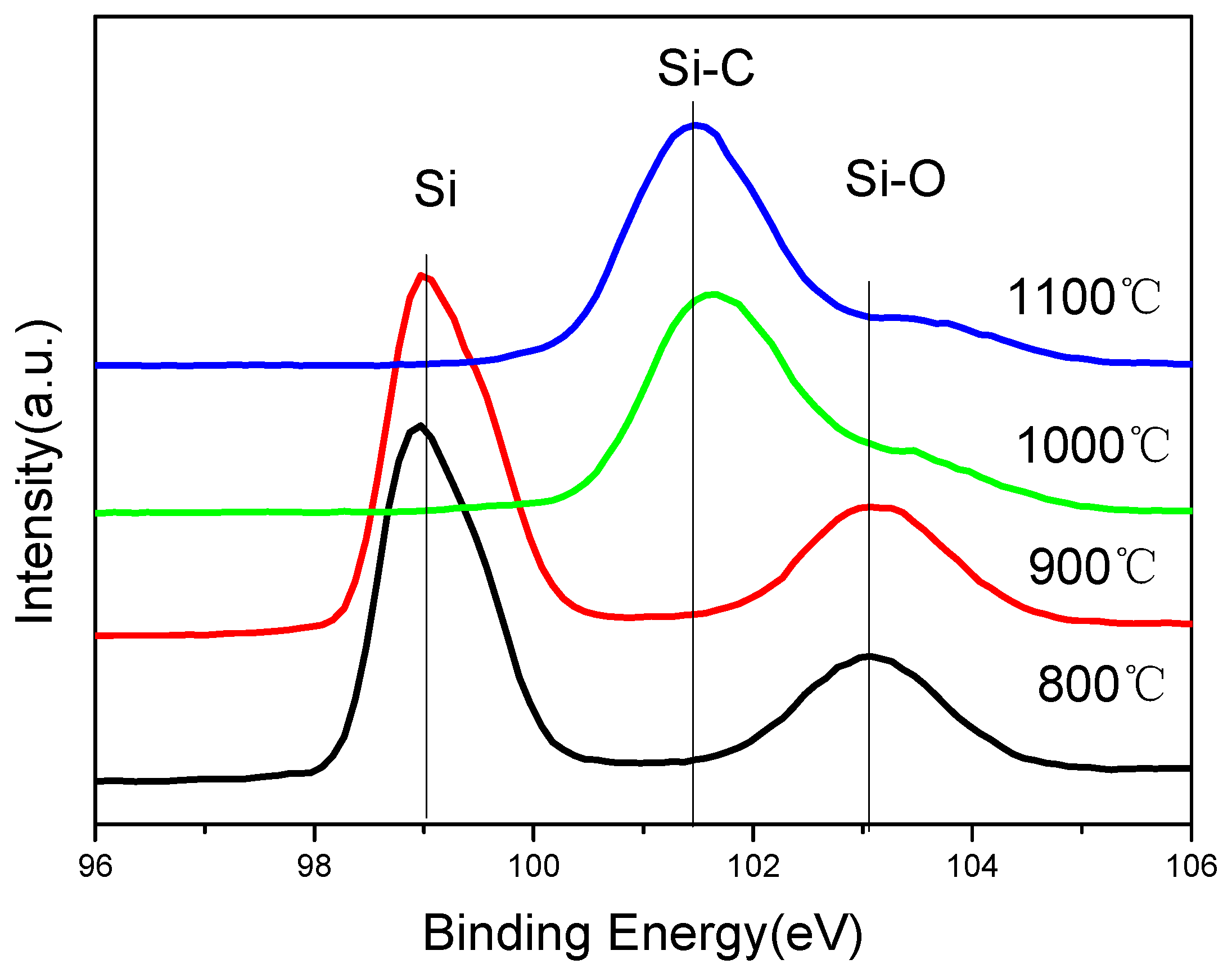

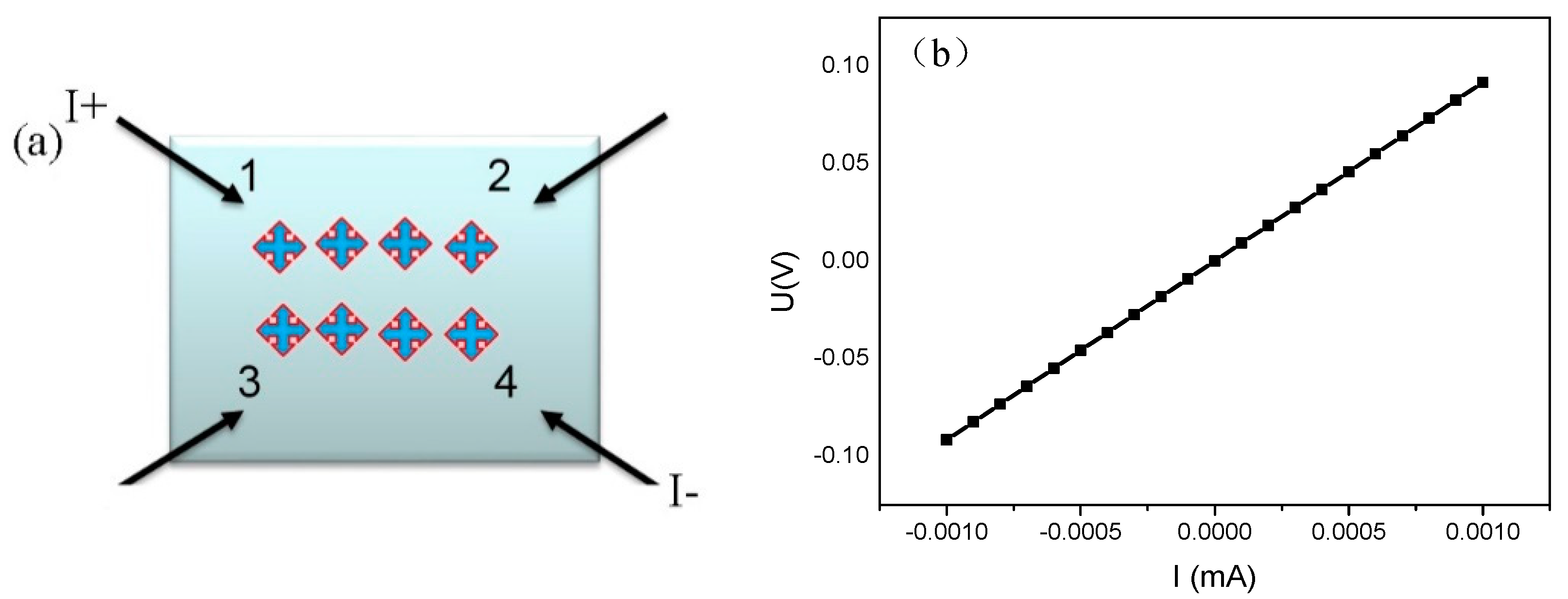
| Sample (Temperature) | Si-C (at%) | Si-O (at%) | sp2-C (at%) | X2 |
| Binding Energy (eV) | 283.5 | 103.5 | 284.7 | |
| 1000 °C | 59.8 | 16.9 | 23.3 | 3.31 |
| 1100 °C | 56.8 | 12.1 | 36.1 | 7.02 |
| 1150 °C | 32.9 | 5.9 | 61.2 | 14.43 |
Disclaimer/Publisher’s Note: The statements, opinions and data contained in all publications are solely those of the individual author(s) and contributor(s) and not of MDPI and/or the editor(s). MDPI and/or the editor(s) disclaim responsibility for any injury to people or property resulting from any ideas, methods, instructions or products referred to in the content. |
© 2023 by the authors. Licensee MDPI, Basel, Switzerland. This article is an open access article distributed under the terms and conditions of the Creative Commons Attribution (CC BY) license (https://creativecommons.org/licenses/by/4.0/).
Share and Cite
Liu, L.; Li, W.; Li, Z.; He, F.; Lv, H. Metal-Free Catalytic Preparation of Graphene Films on a Silicon Surface Using CO as a Carbon Source in Chemical Vapor Deposition. Coatings 2023, 13, 1052. https://doi.org/10.3390/coatings13061052
Liu L, Li W, Li Z, He F, Lv H. Metal-Free Catalytic Preparation of Graphene Films on a Silicon Surface Using CO as a Carbon Source in Chemical Vapor Deposition. Coatings. 2023; 13(6):1052. https://doi.org/10.3390/coatings13061052
Chicago/Turabian StyleLiu, Lintao, Wei Li, Zhengxian Li, Fei He, and Haibing Lv. 2023. "Metal-Free Catalytic Preparation of Graphene Films on a Silicon Surface Using CO as a Carbon Source in Chemical Vapor Deposition" Coatings 13, no. 6: 1052. https://doi.org/10.3390/coatings13061052




